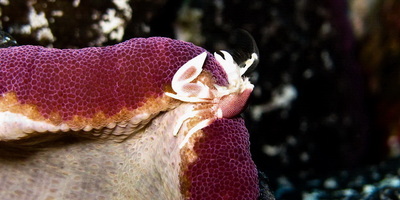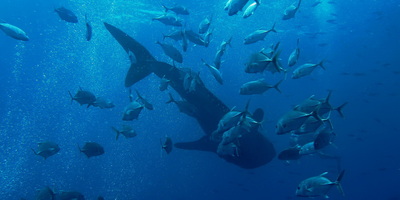Phuket Dive Guide : Koh Bida Nai

About the location and site
Koh Bida Nok, Koh Bida Nai, and Hin Bida are collectively known as the Bida’s. Hin means rock, and is usually used to describe a submerged reef.
Bida Nok and Bida Nai are located only 2 kilometres South of Phi Phi Leh. Both limestone islands, with their outstanding steep walls from 8-28m, are known to be some of the best dive sites of Koh Phi Phi due to the abundance and variety of fish. The shallow reefs are covered with colourful soft corals mixed with hard coral where moray eels, ghost pipefish and scorpion fish hide. Banded sea snakes, turtles and leopard sharks and on occasion whale sharks have been known to visit. In addition, Bida Nai has overhangs, caves and a beautiful archway filled with tiny baitfish, which leads to a shallow hard coral garden. Bida Nok has several swim-throughs of the west side where you find a complex jumble of giant boulders. The limestone-sisters at Phi Phi Islands are not to be missed. Hin Bida lies 8 kilometres further east and is known as Phi Phi Shark Point.
Koh Bida Nok, Koh Bida Nai, and Hin Bida are collectively known as the Bida’s. Hin means rock, and is usually used to describe a submerged reef.
Bida Nok and Bida Nai are located only 2 kilometres South of Phi Phi Leh. Both limestone islands, with their outstanding steep walls from 8-28m, are known to be some of the best dive sites of Koh Phi Phi due to the abundance and variety of fish. The shallow reefs are covered with colourful soft corals mixed with hard coral where moray eels, ghost pipefish and scorpion fish hide. Banded sea snakes, turtles and leopard sharks and on occasion whale sharks have been known to visit. In addition, Bida Nai has overhangs, caves and a beautiful archway filled with tiny baitfish, which leads to a shallow hard coral garden. Bida Nok has several swim-throughs of the west side where you find a complex jumble of giant boulders. The limestone-sisters at Phi Phi Islands are not to be missed. Hin Bida lies 8 kilometres further east and is known as Phi Phi Shark Point.

Koh Bida Nai, which means "Inner Father Island" in Thai, is a limestone island that rises dramatically from the sea 2 kilometres to the south of Phi Phi Leh. Along with its bigger sister Koh Bida Nok just a hundred metres south, this is regarded as Phi Phi's best dive site with an abundance of life.
Above the surface, the limestone rock is stunning with shades of oranges and whites formed by minerals in the rock. Swallows and sea eagles circle its peak.
Most divers start their dive on the southern side of the island, using the mooring line attached to a small boulder formation. A gap in the boulders forms an archway filled with silver glassfish that opens to a spectacular hard coral garden once you swim through it. Bearded scorpion fish are often seen sitting on the bottom here so take care with your buoyancy. On the outer edge of the swim-through on the rock walls you can often seeharlequin ghost pipefish and seahorses. Cracks in the wall hide many surprises like boxer shrimps, hinge-beak shrimps and numerous nudibranchs. Moray eels make their home here too and enjoy having their heads cleaned by the boxer shrimp.
Nearby, a bit more southeast is a large coral outcrop of 3 pinnacles called Fantasy Reef, also indicated by a buoy. Fantasy Reef is an interesting area with very rich coral formations and marine life, worth to spend most of your dive time. Trumpet fish and filefish hover above the gorgonian sea fans, barrel sponges, and sea whips along with banner fish and puffer fish. Schools of squid can also be seen. Look out for lionfish as well as the well-camouflaged scorpion fish. Schools of trevally, barracuda’s, tuna and jackfish hunt above the reef and are a formidable sight as they make constant raids on the thousands of baitfish. When they swirl around divers, it creates breathtaking scenes.
On the way to Fantasy Reef you will pass, a narrow sand patch and a staghorn coral garden where leopard sharks are usually seen resting here. Usually spotted in the early morning’s black-tip reef sharks patrolling the outer edges are a common sight.
On the east side, a drop off with sandy bottom and small coral bommies slopes between 7 and 25 meters. This wall is covered with colourful anemones and their resident clownfish. You can admire the richness of Andaman Sea: titan triggerfish, angelfish, emperor fish, parrotfish, lionfish, moray eels, leopard sharks (). Look out for porcelain crabs on the edges of the anemones. In the shallower area at the base of the rock, look for the bamboo sharks where they have dug sand holes to make their home. Juvenile Oriental sweetlips can be seen performing their unusual dance. Closer in towards the main island is another long narrow swim-through.
The west side of the island is less visited. It is a drift dive north/south or south/north depending on tides.
If you are lucky, whale sharks are spotted around the island at any time of the year.
Above the surface, the limestone rock is stunning with shades of oranges and whites formed by minerals in the rock. Swallows and sea eagles circle its peak.
Most divers start their dive on the southern side of the island, using the mooring line attached to a small boulder formation. A gap in the boulders forms an archway filled with silver glassfish that opens to a spectacular hard coral garden once you swim through it. Bearded scorpion fish are often seen sitting on the bottom here so take care with your buoyancy. On the outer edge of the swim-through on the rock walls you can often seeharlequin ghost pipefish and seahorses. Cracks in the wall hide many surprises like boxer shrimps, hinge-beak shrimps and numerous nudibranchs. Moray eels make their home here too and enjoy having their heads cleaned by the boxer shrimp.
Nearby, a bit more southeast is a large coral outcrop of 3 pinnacles called Fantasy Reef, also indicated by a buoy. Fantasy Reef is an interesting area with very rich coral formations and marine life, worth to spend most of your dive time. Trumpet fish and filefish hover above the gorgonian sea fans, barrel sponges, and sea whips along with banner fish and puffer fish. Schools of squid can also be seen. Look out for lionfish as well as the well-camouflaged scorpion fish. Schools of trevally, barracuda’s, tuna and jackfish hunt above the reef and are a formidable sight as they make constant raids on the thousands of baitfish. When they swirl around divers, it creates breathtaking scenes.
On the way to Fantasy Reef you will pass, a narrow sand patch and a staghorn coral garden where leopard sharks are usually seen resting here. Usually spotted in the early morning’s black-tip reef sharks patrolling the outer edges are a common sight.
On the east side, a drop off with sandy bottom and small coral bommies slopes between 7 and 25 meters. This wall is covered with colourful anemones and their resident clownfish. You can admire the richness of Andaman Sea: titan triggerfish, angelfish, emperor fish, parrotfish, lionfish, moray eels, leopard sharks (). Look out for porcelain crabs on the edges of the anemones. In the shallower area at the base of the rock, look for the bamboo sharks where they have dug sand holes to make their home. Juvenile Oriental sweetlips can be seen performing their unusual dance. Closer in towards the main island is another long narrow swim-through.
The west side of the island is less visited. It is a drift dive north/south or south/north depending on tides.
If you are lucky, whale sharks are spotted around the island at any time of the year.








